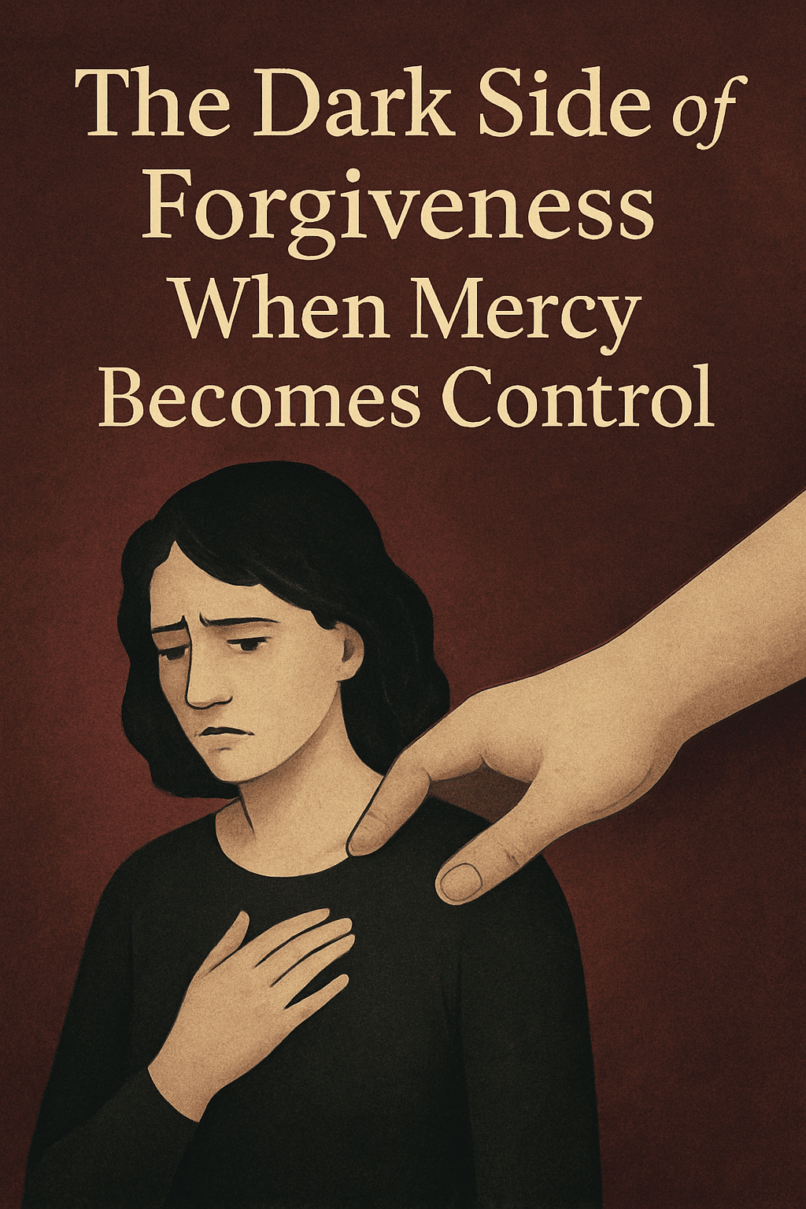
simply amazing, always for you.
The Double-Edged Gift
Forgiveness is often praised as one of the highest virtues. We hear it in church sermons, in self-help books, and in everyday conversations: “Let it go. Forgive and move on.” Forgiveness, we are told, frees both the offender and the offended. It restores relationships, brings peace to the heart, and makes us better people.

But what happens when forgiveness is not about freedom at all? What happens when it becomes a chain rather than a release? There is a darker side to forgiveness—one that is rarely spoken about—where mercy becomes control, where “I forgive you” is less about healing and more about power.
This article explores that shadowy territory. We will look at how forgiveness, when misused, can become a form of manipulation, keeping people bound in guilt rather than freeing them. We will examine the cultural forces that encourage unhealthy forgiveness, the psychological consequences of being trapped in this dynamic, and—most importantly—how to move toward a healthier understanding of what it means to forgive.
Chapter One: The Ideal of Forgiveness
Before we can understand its corruption, we must first acknowledge the beauty of forgiveness. Across cultures and religions, forgiveness is celebrated as a profound act of love.
- In Christianity, forgiveness is central: “Forgive us our trespasses, as we forgive those who trespass against us.”
- In Buddhism, forgiveness is tied to compassion and release from suffering.
- In African traditional wisdom, forgiveness is often linked with restoring communal harmony.
- In modern psychology, forgiveness is seen as a way of releasing resentment and healing emotional wounds.
At its best, forgiveness is liberating. It allows people to let go of grudges, repair broken trust, and rebuild relationships. It restores dignity to both the forgiver and the forgiven.
But because forgiveness is so culturally and morally exalted, it is also vulnerable to distortion. Something so sacred can easily be weaponized, especially in relationships where power imbalances already exist.
Chapter Two: When Forgiveness Becomes a Weapon
On the surface, forgiveness looks like grace. But underneath, it can be sharpened into a blade. Instead of being about release, it becomes a way to bind the other person to a perpetual sense of debt.
Some of the clearest signs of forgiveness as control include:
- The Debt Reminder: “I forgave you, remember? You owe me.”
- Moral Superiority: Using forgiveness to claim the higher ground and keep the other person morally inferior.
- Conditional Love: Making the relationship contingent on gratitude for the forgiveness received.
- Never-Ending Punishment: Bringing up the past repeatedly, even after supposedly forgiving it.
This is not forgiveness—it is a disguised form of domination. The “forgiven” person is not free; they are trapped in the role of perpetual offender, forever grateful, forever guilty.

Chapter Three: The Subtle Language of Control
Forgiveness-as-control rarely comes with shouting or overt threats. It often works through subtle emotional language.
- The Martyr Pose: “I suffered so much because of you, but I’m big enough to forgive.”
- The Silent Treatment: Withholding affection while maintaining the façade of having forgiven.
- Reframing the Wrong: Turning the offense into an eternal narrative of victimhood that elevates the forgiver’s status.
Consider a marriage where one partner strayed years ago. The other partner said they forgave, yet every argument somehow circles back to that betrayal. The wound becomes a permanent tool for leverage, shaping the marriage around guilt rather than healing.
In workplaces, a boss might “forgive” a mistake but hold it over an employee’s head indefinitely, keeping them compliant out of fear.
In families, parents may “forgive” their children but remind them endlessly of past failures, ensuring obedience through shame.
This language is subtle because it cloaks itself in moral righteousness. It pretends to be merciful, but in reality, it keeps the offender small.
Chapter Four: Why We Accept Controlling Forgiveness
If this form of forgiveness is so toxic, why do people accept it? The answer lies in both psychology and culture.
- Fear of Rejection: People cling to forgiveness, even manipulative forgiveness, because it feels better than outright rejection. The forgiven person may accept the guilt as the price of keeping the relationship alive.
- Cultural Pressure: In many communities, forgiveness is non-negotiable. Victims are told to “forgive and forget,” even when harm is ongoing. Refusing forgiveness can be seen as bitterness, pride, or even sin.
- Internalized Guilt: When we already feel ashamed of our actions, we may accept manipulative forgiveness as “what we deserve.” It confirms our belief that we are perpetually flawed.
- Avoiding Conflict: Accepting unhealthy forgiveness can seem easier than challenging it. People may think, “At least things are peaceful now,” even if that peace is built on control.
These dynamics explain why controlling forgiveness thrives—it survives on silence, fear, and shame.
Chapter Five: The Psychological Toll
The consequences of forgiveness-as-control are severe, and they fall on both sides of the relationship.
On the “Forgiven”
- Chronic Guilt: The forgiven person feels like they can never repay their debt.
- Loss of Dignity: They are reduced to a role of permanent wrongdoer, unable to grow past their mistake.
- Anxiety and Fear: They live under constant worry that their offense will be brought up again.
On the “Forgiver”
- Addiction to Power: The act of forgiveness becomes a way to control others rather than heal oneself.
- Stunted Healing: Because the offense is never truly released, the forgiver remains trapped in the past.
- Emotional Isolation: Others may begin to withdraw, sensing that forgiveness is conditional.
On the Relationship
- Erosion of Trust: True intimacy cannot thrive when one person holds perpetual power over the other.
- Repetition of Harm: Old wounds are reopened again and again, preventing genuine reconciliation.
- Corrosive Atmosphere: The relationship becomes defined by past mistakes rather than present possibilities.
The tragedy is that both people remain chained—one to guilt, the other to bitterness disguised as virtue.
Chapter Six: Forgiveness vs. Boundaries
A crucial distinction must be made between true forgiveness and enabling harm.
- True Forgiveness: A conscious release of resentment, without keeping the offense as a weapon.
- Forgiveness-as-Enabling: A forced or manipulative pardon that allows unhealthy patterns to continue.
Forgiveness does not mean:
- Forgetting the harm.
- Allowing the offender continued access to your life.
- Giving up your right to be angry or to set boundaries.
In fact, the healthiest forms of forgiveness often come with firm boundaries. For example, someone might forgive an abusive partner emotionally (choosing not to carry hate), but still leave the relationship. That is authentic forgiveness—release without control, compassion without enabling.
Chapter Seven: Breaking Free from Forgiveness-as-Control
Escaping this dynamic requires courage and clarity. Here are steps toward freedom:
- Recognize the Pattern: Notice when forgiveness feels like debt rather than release.
- Name It: Language matters. Instead of silently accepting, acknowledge—at least to yourself—that this is manipulative forgiveness.
- Set Boundaries: Decide what you will no longer tolerate. If forgiveness is used as a leash, you may need to step back.
- Communicate Directly: When safe, express how the dynamic affects you. Example: “I appreciate your forgiveness, but when the past is brought up repeatedly, I feel trapped rather than healed.”
- Seek Support: Therapy, trusted friends, or community can help break the cycle.
- Reframe Forgiveness: Understand that forgiveness is not about debt or superiority—it is about releasing both people from the past.
Breaking free does not always mean ending the relationship, but it always means reclaiming dignity.
Chapter Eight: The Paradox of Mercy
Forgiveness is paradoxical. It has the power to liberate—but also the potential to enslave. It can restore life, or it can stifle it.
The paradox is resolved only when we see forgiveness not as a transaction but as an act of release. True forgiveness does not demand ongoing gratitude or submission. It does not hold the past hostage. It allows people to walk forward unchained.
When forgiveness becomes control, it is no longer forgiveness at all. It is simply another form of bondage dressed up as virtue.
Toward Genuine Freedom
Forgiveness should be a gift of release, not a rein of control. Yet too often, it is twisted into something that binds rather than frees. By understanding the dark side of forgiveness, we can avoid falling into patterns of manipulative mercy.
The call, then, is not to abandon forgiveness but to practice it more authentically. Forgiveness must be rooted in freedom, in dignity, in the courage to let go without demanding submission. And when forgiveness is used as control, the bravest response may be to refuse it—to step back, set boundaries, and insist on a love that is not chained to the past.
In the end, genuine forgiveness is not about power but about peace. And peace cannot exist where mercy is used to dominate.
SUGGESTED READS
- The Psychological Effects of Infidelity on Marriage: A Deep Exploration
- How African Proverbs Promote Emotional Intelligence in Relationships
- African Proverbs for Navigating Long-Distance Relationships
- Parenting and Partnership: African Proverbs on Raising Children in Love
- How to Use African Proverbs in Wedding Vows and Speeches

Support Our Website!
We appreciate your visit and hope you find our content valuable. If you’d like to support us further, please consider contributing through the TILL NUMBER: 9549825. Your support helps us keep delivering great content!
If you’d like to support Nabado from outside Kenya, we invite you to send your contributions through trusted third-party services such as Remitly, western union, SendWave, or WorldRemit. These platforms are reliable and convenient for international money transfers.
Please use the following details when sending your support:
Phone Number: +254701838999
Recipient Name: Peterson Getuma Okemwa
We sincerely appreciate your generosity and support. Thank you for being part of this journey!

kyvkyentnxtlhlwmmxqrkmoqzolqdm
Digestive Health Supplement